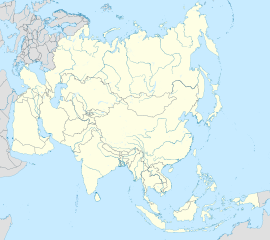
Back مطار كابل الدولي Arabic Hamid Kərzai adına Beynəlxalq Hava Limanı Azerbaijani Міжнародны аэрапорт Кабул Byelorussian হামিদ কারজাই আন্তর্জাতিক বিমানবন্দর Bengali/Bangla Aeroport Internacional Hamid Karzai Catalan Kabul International Airport CEB فڕۆکەخانەی نێونەتەوەییی حامید کارزای CKB Mezinárodní letiště Kábul Czech Flughafen Kabul German Διεθνές Αεροδρόμιο της Καμπούλ Greek
Kabul International Airport Pashto: د کابل نړیوال هوايي ډګر Dari: میدان هوائی بین المللی کابل | |||||||||||
|---|---|---|---|---|---|---|---|---|---|---|---|
 The airport's flightline in January 2012 | |||||||||||
| Summary | |||||||||||
| Airport type | Public | ||||||||||
| Owner | Ministry of Transport and Civil Aviation | ||||||||||
| Operator | GAAC Holding[1] | ||||||||||
| Serves | Kabul | ||||||||||
| Location | Kabul, Afghanistan | ||||||||||
| Hub for | |||||||||||
| Built | 1960[2] | ||||||||||
| Elevation AMSL | 1,791 m / 5,877 ft | ||||||||||
| Coordinates | 34°33′57″N 069°12′47″E / 34.56583°N 69.21306°E | ||||||||||
| Website | kia | ||||||||||
| Maps | |||||||||||
 A 2015 United States Air Force diagram of the airport | |||||||||||
Location of the airport in Afghanistan | |||||||||||
 | |||||||||||
| Runways | |||||||||||
| |||||||||||
Source: AIP Afghanistan[3] | |||||||||||
Kabul International Airport (IATA: KBL, ICAO: OAKB) is located in the northern part of Kabul, Afghanistan. It is one of the country's main international airports, capable of housing over a hundred military and civilian aircraft. It is currently operated by UAE-based GAAC Holding and Afghanistan's Ministry of Transport and Civil Aviation.[1]
The airport was originally named as Khwaja Rawash Airport because it was built in the area named Khwaja Rawash. It was given the name Kabul Airport in 1960 after the Soviet Union built a terminal and a concrete runway. From 2014 to 2021, it was named Hamid Karzai International Airport[4][5] in honor of former President Hamid Karzai. After the Taliban returned to power in 2021, the name was changed back to Kabul International Airport.[5]
Sitting at an altitude of approximately 1,791 m (5,876 ft) above sea level, the airport is surrounded by parts of the Hindu Kush mountains.[6] It serves as a hub for Ariana Airlines and Kam Air. International companies such as Air Arabia, Flydubai and Turkish Airlines also provide passenger services.[7]
The airport has two separate terminals, one for international passengers and the other for domestic flights. It also has a number of empty military bases, which were previously used by the United States Armed Forces and NATO's International Security Assistance Force (ISAF) and later the Resolute Support Mission (RS). The Afghan Air Force also had a base at the airport,[8] with the Afghan National Security Forces providing security inside the passenger terminals.
Prior to the withdrawal of US-led forces in 2021, the airport provided scheduled flights to and from China, India, Iran, Pakistan, Russia, Tajikistan, Turkey, Uzbekistan, and the Persian Gulf region. The most frequently serviced destination from the airport has been Dubai in the UAE, with no fewer than four passenger airlines flying the route, and some with multiple daily flights.[9][10]
Other nearby major airports to Kabul are Bagram Air Base in neighboring Parwan Province to the north, Jalalabad Airport in Nangarhar Province to the east, Khost International Airport in Khost Province to the southeast, and Bamyan Airport in Bamyan Province to the northwest.
- ^ a b Mohammad Yunus Yawar (8 September 2022). "Taliban to sign contract with UAE's GAAC Holding over airspace control at Afghan airports". Reuters. Retrieved 14 November 2022.
- ^ Cite error: The named reference
handbookwas invoked but never defined (see the help page). - ^ AIP Afghanistan - Important Information Archived 2016-06-17 at the Wayback Machine
- ^ Cite error: The named reference
Cabwas invoked but never defined (see the help page). - ^ a b Cite error: The named reference
:2was invoked but never defined (see the help page). - ^ "For Pilots, Kabul Evacuations a Flight Like No Other". Voice of America. 26 August 2021. Retrieved 31 August 2021.
- ^ "Turkish Airlines Resumes Flights to Afghanistan Nearly 3 Years After the Taliban Captured Kabul". Associated Press. U.S. News & World Report. 21 May 2024. Retrieved 21 May 2024.
- ^ "Super Tucano in Service in U.S. Air Force". dialogo-americas.com. Archived from the original on 2 September 2018. Retrieved 16 January 2018.
- ^ "OAKB - Hamid Karzai International Air Airport | SkyVector". skyvector.com. Retrieved 7 August 2020.
- ^ "OAKB/Hamid Karzai International Kabul General Airport Information". acukwik.com. Retrieved 7 August 2020.



